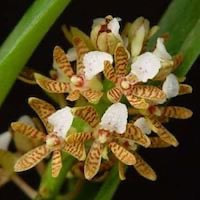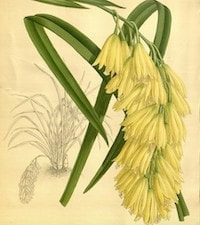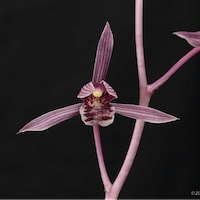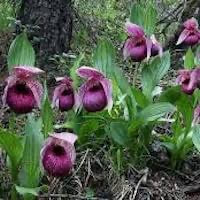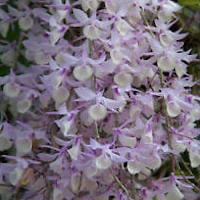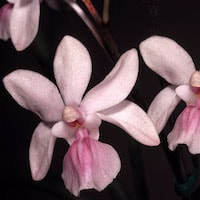MWD12- Men's Woody 12 - Happy Ending
|
Native Singaporean Orchid notes: Procatavola Wufong Jade
Procatavola Wufong Jade, a hybrid orchid derived from Cattleychea Siam Jade and Brassavola nodosa, is utilized in the Woody 12 (Men) team building Perfume workshop primarily for its strong fragrance. This orchid features compact flowers with green petals and sepals, complemented by a large, tubular white lip with a creamy yellow center and a hint of pink. Orchids like Procatavola Wufong Jade are favored in perfume workshops for their unique scents, which participants extract to create bespoke fragrances. Orchids contribute diverse aromas that add complexity and appeal to perfumes, making them ideal for exploring different scent combinations and preferences in workshop settings.
|
Therapeutic Orchid notes:
|
Acampe praemorsa
Acampe praemorsa, known by various names across India and Asia like Marabale, Maravasha, Khanbher, and Rasna, is an orchid species valued in traditional medicine. In India, its root decoction, Rasna, serves as a bitter tonic for treating rheumatism, sciatica, neuralgia, syphilis, and uterine disorders. Tribes like Dongria Kandha use it orally for arthritis, while the Koya apply it as a paste on fractures for healing. Rich in flavonoids like flavidinin and praemorsin, Acampe praemorsa demonstrates potential medicinal properties, although further research is needed to confirm its efficacy and safety. |
|
Cymbidium elegans Lindl. var. elegans Syn. Cymbidium longifolium D. Don.
Cymbidium elegans var. elegans, also known as Suocao Lan in Chinese, is an orchid species distinguished by its numerous flowers on the inflorescence's main axis and lip lamellae lacking appendages. In traditional medicine, its tuber-derived salep is used in India as a demulcent for soothing inflamed tissues or as an emetic to induce vomiting. The orchid's fresh leaf juice is also applied to staunch bleeding from deep wounds, suggesting potential hemostatic properties. However, further research is needed to validate these traditional uses and ensure safety. |
|
Cymbidium sinense (Jacks.) Willd. Syn. Cymbidium chinense Heynh.
Cymbidium sinense, also called Baisui Lan, Baosui Lan, Chun Lan, and Mo Lan in Chinese, is widely found across Asia from India to Japan's Ryukyu Islands. It blooms from October to March in China. In traditional medicine, various parts of the plant, especially its roots collected in autumn and sun-dried, are used. It's believed to cleanse the heart and lungs and treat respiratory issues like coughs and asthma. Scientific research is needed to confirm these uses and ensure safety before using Cymbidium sinense for medicinal purposes. |
|
Cypripedium macranthos Sw.
Cypripedium macranthos, also known as big-flowered spoon orchid, has various Chinese names like Qilaixipuxie Lan, Dahuashao Lan, and Dakoudaihua, and is called Dunshengcao or Wugongqi in Chinese medicine, and Atsumoriso in Japanese. It contains bioactive compounds such as lusianthrin and chrysin, known for their antifungal properties. In Chinese traditional medicine, its roots and stems are used to treat conditions like swelling, bruises, pain relief, and improving urine production. Despite its historical use, more scientific research is necessary to confirm its medicinal benefits and ensure safety before widespread use. |
|
Dendrobium aphyllum (Roxb.) C.E.C. Fisch, syn. D. macrostachyum Lindl.
Dendrobium aphyllum, also known as Dendrobium macrostachyum, is an orchid species found in Southeast Asia, including Thailand, southwest China, Sikkim, and Nepal. In traditional medicine, its stems are used in Nepal as tonics to promote health. In India, the Valmikis tribe uses the juice of young pseudobulbs to treat earaches. Additionally, dried stems are used as shihu in traditional Chinese medicine. Despite its traditional uses, scientific research is needed to confirm its medicinal benefits, safety, and proper usage. Consulting healthcare professionals before using Dendrobium aphyllum or any herbal remedy is recommended. |
|
Holcoglossum amesianum (Rchb. f.) Christenson
Holcoglossum amesianum, also known as Dagencaoshe Lan in Chinese, is an epiphytic orchid that grows on limestone rocks in shaded areas. It is used in traditional Chinese medicine and Myanmar for various health benefits. In Chinese medicine, the whole plant is used as an antipyretic to reduce fever and is believed to have anti-inflammatory properties that can treat inflammation. It is also used to improve blood circulation, act as a diuretic, and have antimicrobial effects. Despite its traditional uses, scientific research is needed to confirm its medicinal benefits, safety, and proper usage. Consulting healthcare professionals before using Holcoglossum amesianum or any herbal remedy is recommended. |
Other scent note
Scentopia Library Reference ingredient
Vetiver - Check details at Scentopia's scent library
Download the guided mediation that works best with this Orchid fragrance oil
| men_woody_essential_oil_orchi_00012.mp3 | |
| File Size: | 169120 kb |
| File Type: | mp3 |

